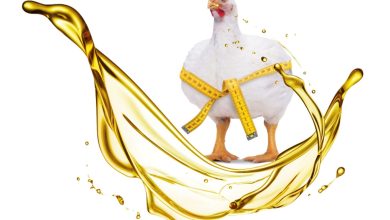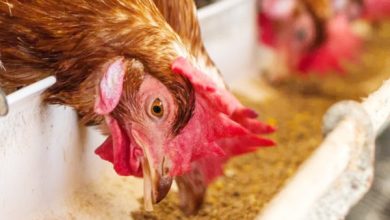Effect of dietary acidifier on performance of broiler chickens

Dr Onkar Pawaskar and Dr Mangesh Sagar
Feed additives containing low-molecular-weight organic acids are called as acidifiers. The importance of low-molecular-weight organic acids in livestock nutrition increased considerably in response to the ongoing ban on feed antibiotics. Different combinations of organic acids are used in feed of animals against bacterial infections. The dry form acidifiers contain organic acids, organic acid salts or their blends, usually based on carriers, which do not react chemically with the active ingredient. They are used in poultry nutrition for the purpose of maintaining the digestive pH at a level to prevent the growth of pathogenic bacteria. They also show bactericidal activity against pathogenic intestinal microflora. Most often, pathogenic bacteria begin to develop in the digestive tract when the lumen pH of the small intestine and caecum exceeds 5.8, and that of large intestine exceeds 6.2 The multiplication of pathogenic microorganisms in the intestine may result in the inflammation of intestinal mucosa or necrosis of intestinal epithelium. This causes increased secretion of intestinal fluids which leads to diarrhoea. Diarrhoea and the associated dehydration cause birds to go off fed and may lead to their death in a very short period of time.
Cereals used for feed production may contain pathogenic bacteria and moulds, which may synthesize harmful mould toxins under poor storage conditions. Low-molecular-weight organic acids, particularly propionic acid have a strong inhibitory effect on the growth of moulds.
The amount of acidifier recommended for inclusion in poultry diets depends on several factors, mainly on alkalizing effects of feed ingredients and mineral supplement such as calcium sources. Under production conditions, the ban on feed antibiotics may result in considerable mortality rates, especially during the first 21 days of the birds. According to modern farming standards, chicken mortality rates must not exceed 3%. Excessive mortality may be due to the strong alkaline effect of high protein content of diets for young birds, when the digestive tract and its secretary capacity are not fully developed.
The aim of the study was to determine the effect of various organic acids on broiler performance.
Materials and Methods
A total of 1024 day-old cobb broiler chicks were randomly divided into 4 groups, with 4 replicates of 64 birds. Birds in each replicate were kept in pens covered with saw dust. Shed temperature, humidity and ventilation were maintained in accordance with hygiene standards for young birds. The birds were vaccinated against F1 and IBD at day 5 and 12 respectively. All chickens received ad libitum starter type diets (1–21 days) followed by grower type diets (22–42 days). The diets were composed of ground maize and soybean meal as the main ingredients (Table 1). Water was provided ad libitum throughout the trial. I P CID an acidifier from Volschendorf was added to trial diets at different dose rates and the control group was fed without any acidifier.
Feed consumption and mortality were recorded throughout the study and the feed conversion ratios were subsequently calculated.
Table1. Components and nutritive value of the diets
| Item | Diet | |
| Starter (1–21 days) | Grower (22–42 days) | |
| Feed ingredients (%) | ||
| Maize | 60.10 | 64.10 |
| Soybean meal | 32.50 | 28.50 |
| Oil | 4.00 | 4.00 |
| Dicalcium phosphate | 1.70 | 1.70 |
| Limestone | 0.60 | 0.60 |
| NaCl | 0.35 | 0.35 |
| L-lysine HCl (78%) | 0.11 | 0.11 |
| DL-methionine (99%)
|
0.14 | 0.14 |
| Mineral Mixer
|
0.10 | 0.10 |
| Vitamin premix | 0.05 | 0.05 |
|
Percent Nutrients in diet
|
||
| Lysine | 1.2 | 1.0 |
| Methionine | 0.52 | 0.57 |
| Crude fat | 2.7 | 2.4 |
| Crude fibre | 3.5 | 4 |
| Calcium | 0.97 | 0.92 |
| Phosphorus | 0.52 | 0.51 |
Results
Adding the acidifier to chicken feeds reduced the pH of starter diet from 6.90 to 5.89, and that of the grower diet from 6.28 to 5.73. Supplementing diets with the increasing amounts of acidifier (from 1.5 to 3 kg/ton of feed) significantly increased body weight of chickens at 21 and 42 days of age compared to the control birds (Table 2). Mortality decreased significantly, with significant differences in relation to the control group. Feed consumption has slightly increased at 2kg and 3kg IP CID added groups but feed conversion remained approximately same. Feeding the acidifier significantly increased carcass weight at 43 days of the experiment (Table 3). Significant differences were found in dressing percentage, which was the highest with the acidifier supplemented at 2 kg/ton and the lowest at 3 kg/ton, but was still higher compared to the control value.
Table2. Growth performance of broiler chickens
| Item | Control | I P Cid at different dosage (g/kg diet) | ||
| 1.5 | 2 | 3 | ||
| Body weight at 21 days (g) | 702 | 764 | 758 | 759 |
| Body weight at 42 days (g) | 2687 | 2732 | 2776 | 2772 |
| Mortality (%) | 2.6 | 0.4 | 0.58 | 1.2 |
| Feed Intake (g/bird) at 42 day | 4621 | 4617 | 4885 | 4795 |
| F.C.R. | 1.72 | 1.69 | 1.76 | 1.73 |
The results of this study show that the dietary level of 0.15, 0.2 or 0.3% acidifier, increases the growth rate of chickens during both the first 21 days of age and over the entire 42-day period. Better body weight gain was accompanied by increased feed consumption, although no significant differences were found in feed conversion ratio.
These data may be indicative of the superior conversion of the amino acids and energy from the acidifier supplemented diets and of the superior conversion of energy into broiler tissues.
Table3. Carcass weight and dressing percentage
| Item | Control | I P Cid at different dosage (g/kg diet) | ||
| 1.5 | 2 | 3 | ||
| Slaughter weight (g) | 2795 | 2846 | 2881 | 2894 |
| Carcass weight (g) | 1977 | 2056 | 2099 | 2082 |
| Dressing percentage | 70.73 | 72.25 | 72.86 | 71.95 |
The gradual increase in acidifier amounts in the experimental diets prevented mortality in chickens. The mortality had drastically reduced. This suggests that the acidifier protected the chickens from intestinal infections and gastrointestinal disorders, which are a common cause of mortality. In the present experiment, in terms of stocking density and body weight per unit floor area, the housing conditions were similar to the conditions used in large scale production.
The I P CID acidifier used in the current experiment contained acetic acid, propionic acid, formic acid, butyric acid, citric acid and lactic acid. The acidifying effect persisted into the final section of the digestive tract, which is the least acidic and most vulnerable to growth of pathogenic bacteria.
The results cited above indicate that the increase in chickens’ body weight is in response to acidifying additives. It is of economic importance that the acidifiers significantly reduced chicken mortality in the study mentioned above.
In conclusion, due to the high protein contents, in addition to minerals, conventional broiler diets may have a highly alkalizing effect. Because the digestive tract of chickens is not ready to counteract the effects of alkaline digesta, the administration of acidifiers and additives that reduce digesta pH seem the most important factor regulating the status of intestinal microflora. Our study with I P CID acidifier showed that the most advantageous dietary level of this feed additive ranges from 1.5 to 3 kg/ton, with 2 kg/ton regarded as the optimum dose.


